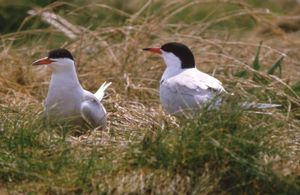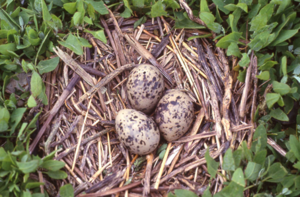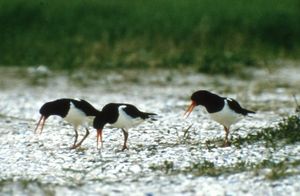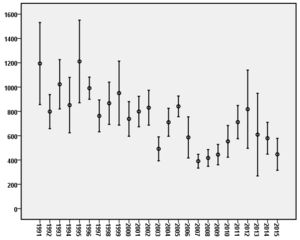TMAP
Contaminants in Bird Eggs in the Wadden Sea (TMAP)
Marine birds may serve as bioindicators for the marine environment. Since 1981 Prof. Dr. Peter H. Becker at the Institute of Avian Research has been investigating the contamination of seabirds with environmental chemicals by analysing the fresh egg. Since 1985 samples have been collected on an annual basis at selected sites on the German Wadden Sea coast, and since 1998 in the international Wadden Sea. Indicator species are Common Tern and Oystercatcher. Since 1999 all chemical analyses of environmental chemicals (e.g. Hg, different PCB-Congeners, DDT and Metabolites, HCB, HCH and Isomeres, Chlordan and Nonachlor-compounds) take place at the ICBM (Terramare). Since 2014 it is also responsible for the logistical support and statistical evaluation of the whole project.
 |  |
|---|---|
| Fig. 1: Common tern: left adult birds breeding and right clutch with three eggs (photo D. Frank, P. Becker) | |
At the end of the 1980s the project evolved into a monitoring scheme which, since 1998, has been carried out as part of the TMAP (Trilateral Monitoring and Assessment Program). With its more than 30-year data series the Project has one of the world's most comprehensive sources of information on the chemical contamination of biota with mercury and organochlorines in the Wadden Sea.
 |  |
|---|---|
| Fig. 2: Oystercatcher: left adult birds foraging (photo R. Nagel) and right for the e.g. the temporal development of PCB concentrations (ng/g fresh weight) in Oystercatcher eggs from 1991 to 2015 at the Jade bay. | |
This project is also a logistical platform for other basic investigations on the importance of environmental chemicals not only for marine birds (e.g. Goutner et al. 2015).
The monitoring is focused on:
- Temporal trends of contamination
- Spatial trends of contamination
- Interspecific differences in contamination
- Variation of contaminant patterns (compostion by PCB congeners, DDT and metabolites)
- Possible impacts of the recent contaminant concentration on the birds
The results go the Wadden Sea states as commissioners and to data banks (Wadden Sea, MUDABA) and are used as an early warning system. The guidelines for the project have been adopted in international concepts for monitoring (Ecological Quality Objectives, ICES, OSPAR).
Currently availbale toxicological analyses:
- HG
- Different PCB Congeners
- DDT and metabolites
- HCB
- HCH Isomers
- Chlordan- and Nonachlorderivatives
Collaborations:
If interested in ecotoxicological analyses or collaboration in contaminants in bird eggs studies please contact:
Prof. Dr. Peter Schupp ICBM, University of Oldenburg: peter.schupp@uol.de
Financial support:
The Wadden Sea states, The Netherlands, Lower Saxony, Schleswig-Holstein and Denmark. TMAP Program runs since 1998 and will continues at least until 2020.
Selected publications:
Becker, P.H. & J. Muñoz Cifuentes (2005): Contaminants in Bird Eggs: Recent spatial and temporal trends. Wadden Sea Ecosystem No. 18, 5-25. Common Wadden Sea Secretariat, Wilhelmshaven.
Becker PH, Dittmann T (2009) Contaminants in Bird Eggs. Thematic Report No. 5.2. In: Marencic, H. & Vlas, J. de (Eds), Quality Status Report 2009. WaddenSea Ecosystem No. 25. Common Wadden Sea Secretariat, Trilateral Monitoring and Assessment Group, Wilhelmshaven, Germany.
Dittmann T, Becker PH, Bakker J, Bignert A, Nyberg E, Pereira MG, Pijanowska U, Shore R, Stienen EWM, Toft GO, Marencic H (2011) The EcoQO on mercury and organohalogens in coastal bird eggs: report on the pilot study 2008-2010. INBO.R.2011.43, Research Institute for Nature and Forest, Brussel, 72 pp
Dittmann T, Becker PH (2012): Umweltqualitätsziele für die Kontamination von Eiern mariner Vogelarten der Nordsee mit Quecksilber und Organochlorverbindungen. Gefahrstoffe - Reinhaltung der Luft 72: 139-144
Dittmann T, Becker PH, Bakker J, Bignert A, Nyberg E, Pereira, MG, Pijanowska U, Shore R, Stienen EWM, Toft GO, Marencic H (2012) Large-scale spatial pollution patterns around the North Sea indicated by coastal bird eggs within an EcoQO programme. Environmental Science and Pollution Research 19:4060-4072; DOI: 10.1007/s11356-012-1070-2
Goutner V, Bakaloudis DE, Papakosta M, Vlachos CG, Mattig FR, Pijanowska U, Becker PH (2015) Organochlorine and mercury residues in eggs of the lesser kestrel (Falco naumanni) from a long term study in an easter Mediterranean colony. Environ Pollut 207: 196-204
Goutner V, Becker PH, Liordos V (2011) Organochlorines and mercury in livers of great cormorant (Phalacrocorax carbo) wintering in wetlands of north-eastern Mediterranean in relation to area, bird age and gender. Science Total Environ 409: 710-718, DOI 0.1016/j.scitotenv.2010.10.043
Mattig FR, Pijanowska U, Becker PH (2014) Thirty-two years of Monitoring Pollutants with Seabirds in the Wadden Sea. Wader Study Group Bull 121 (2): 70



![[Translate to English:]](/f/5/_processed_/3/2/csm_ICBM-Logo-transparent-_91fe1c6774.png)